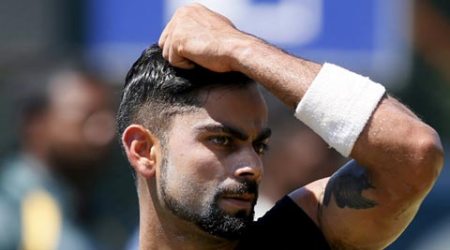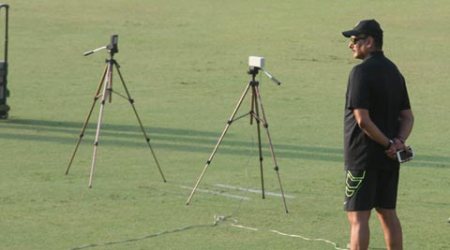 The St Patrick’s College ground in Jaffna has the only turf wicket in the entire northern province. Photos: Sandip G
The St Patrick’s College ground in Jaffna has the only turf wicket in the entire northern province. Photos: Sandip G
In a ramshackle asbestos chamber, stacked with broken boards and rusted chairs, an elderly sentinel of Jaffna’s St Patrick’s College Ground struggles to keep himself awake. His periodic post-lunch naps are intervened by the strident barks of a pack of strays, housed in a crumbling shed that hugs the ground under a hunched palmyra tree. He swishes his wooden stick in thin air and pelts a few craggy stones from his pocket. The dogs splinter astray.
His sleepy eyes then bumble on a skinny cow grazing into the centre of the ground. He nonchalantly walks up to it, pulls it by the rope on the neck and ties it to the pole of a goalpost, before returning to the chamber and washing his eyes with water to be more vigilant of intruders. “Vacation time ana ithu than tholla (in vacation time this is the biggest menace),” he mutters.
Schools in Sri Lanka are shut in August, the longest vacation of their academic year. The otherwise brimming ground is an eerily empty place. Thangavelu dreads the month, for he has to guard the ground from dogs and cows and “poruki pasanga” (rascals guys) who aim to turn the ground into a midnight watering hole. Not long ago, he used to vacation the month at home, but not after the college installed a turf wicket, the only such facility in the northern province, which comprises five districts and spans nearly 9,000 square kilometres.
It was readied by the Sri Lanka Cricket Board, three years ago, to facilitate the growth of cricket in the once strife-torn Jaffna peninsula.
The school, though, has to maintain the surroundings, and recently it got a roofed stand and a small gallery, which are packed during local derbies.
The turf wicket has stirred envy among other local schools, especially affluent ones like St John’s and Jaffna Hindu College, but on it dwells the biggest hope of the northern province producing its first ever international cricketer. At the peak of the war, it would have been blasphemous to even suggest this, but now the uneasiness has abated and sporting dreams have begun to sprout. And it’s all centred on the 22-yard strip of one of the oldest colleges in the country, founded by an Italian missionary. “We nurture it like a baby, because we know how precious it is and how lucky we are to have this facility. So we have to make the best use of it,” says Amaldas Nishanthan, the physical education teacher, who was a household name in his time, though he keeps asserting he played only on matting wickets. As if it’s some kind of slight.
Back in his time, in the mid 90s, when peace was delusional on the peninsula, Nishanthan says nobody knew turf wickets existed. “Only if we could go out of Jaffna could we see the turf wickets, which we couldn’t. It was in the early 2000s, when truce talks were underway and the roads reopened, that I first went out of Jaffna. But then the war was back again and the roads (doors) were shut,” he recollects.
The civil war hardly affected their provincial cricket, but it stalled the ambitions. “Those days we couldn’t even dream of dreaming about playing for Sri Lanka. We would have been branded traitors for sure even if we did, but then we were content that we could play cricket at least among the districts. It was a big relief for us. At least there was some peace and joy in our lives,” he says.
So all his life, Nishanthan, a prolific wicketkeeper-batsman, played his cricket on matting surfaces, with its moody bounce and whimsical disposition. But it made him a fine player square of the wicket. “I could cut, pull, and hook without any inhibitions. Also, keeping on such wickets sharpened my reflexes,” he says, his otherwise inexpressive face suddenly radiating with a puerile joy.
His fame traversed beyond the Elephant Pass and a bunch of visiting Sri Lankan cricket administrators were so impressed that they even chalked out a plan to smuggle him out of Jaffna though the Jaffna-Trincomalee-Colombo cargo route. He laughs wistfully, before admitting self-deprecatingly, that he was not brave enough. “I didn’t have the courage and getting out of Jaffna was risky and complicated,” he says.
He had to evade the eyes of LTTE cadets, the Sri Lankan Navy and the Army. More agonisingly, he had to stay away from his family, which, in those uncertain times, was mentally torturous. “You don’t know what will happen to them, and you don’t know whether you can even come back,” he says.
But Nishanthan and his friends used to impatiently wait for the cargo boats to dock at Trincomalee harbour, which, among other supplies, used to bring cricket goods. “We had to order the goods and pay three times the money. But that was one of the few things we could look forward to in our lives,” he says.
Even if he had managed to sneak into Colombo, there was no guarantee that he would prosper. “The cricketers there were and still are a few notches above us in terms of confidence, support and the game. Being a good player on matting wicket doesn’t automatically make you a great player on turf,” he points out.
After the ambush of 2009, when the entire LTTE cadre was annihilated through a brutally clinical operation, and peace restored, a few youngsters like wicketkeeper-batsman Rishan Tudor, left-arm spinner G Gokulan and medium pacer Edward Edin did make it to Colombo.
But they found the gulf too huge to bridge and are still playing third-division cricket. “Rishan was a Patrician and is a talented boy, but the competition there’s so immense that climbing up the ladder is really difficult. Let’s face it, we are a few years behind the cricketers from Colombo and Kandy, which is understandable given the hardships we had endured,” Nishanthan sighs.
It’s not just infrastructural incompetence or decades of geographical alienation that has stymied Jaffna cricket – he insists that in the pre-war days, Jaffna was a cricketing powerhouse – but also societal and class disparities. “If you look at the students here, 70 per cent of them are from fishermen background, for whom sending their kids to college itself is a big accomplishment. Even look at the coaches here. We are not paid in lakhs as they do in St Joseph’s or Trinity. They even have specialised coaches. But here we are coaching the kids voluntarily, without getting a penny,” he says.
The biggest fillip for cricket in Jaffna will be if one of their 24 clubs progresses to the A division, but the best they’ve managed to reach is the pre-quarters of the third division. “At this moment, we are looking at not getting demoted to the fourth division,” says Nishanthan.
Like most of them associated with cricket in the vast stretches of the northern province, Nishanthan believes that turf wicket will sooner than later change their cricketing fortunes around. Now, the board has commissioned to build a international stadium as well. “Jaffna no longer wants to be associated with war, but as a cricketing powerhouse, as it once was,” he says. But it has spoiled Thangavelu’s meditational slumber.
***
The paint on the walls of St Patrick’s College is peeling. Like the town, the college too has bore the brunt of war. At the peak of the conflict, the college was a shelter to the victims and a dispensary. There were a few times the college ground was shelled by the Sri Lankan Army in the 80s. So, perhaps they cared less about preserving photographs. The remains of the past glory are just a handful of faded black-and-white photographs. Nishanthan’s index finger runs through the names on an old photograph with men in blazers holding a trophy, before it stops at one particular name. R Naguleswaran, a stocky man with a disarming smile, who played for their rivals Jaffna Central College. “He was one of the great fast bowlers, who couldn’t unfortunately play Test cricket,” he says.
A brisk left-arm seamer, who was a popular figure on the Colombo club circuit, Naguleswaran had emigrated to New Zealand, like several others from the northern province, just a little before Sri Lanka was accorded Test status. Thus was assumed that Jaffna could churn out fast bowlers. Former fast bowler and in-charge of talent development in the northern and eastern provinces, Ravindra Pushpakumara credits it to their naturally athletic built. “They are strong and sturdy and so have the ideal physique for fast bowlers. You won’t believe it, they can bowl for hours on end without even drinking water. That’s why we are focusing more on developing fast bowlers from this area,” he says.
He was also stunned by their classical actions. “When I look at these players from the north and east, I simply marvel at them. Some of these players are so naturally gifted. Their actions are so classical that there’s nothing that we have to correct. I only update them on the proper technique,” Pushpakumara says.
So he asked a couple of them whether they had developed their techniques watching television or Youtube videos. They replied with empty stares. “Forget Youtube, most of them don’t have even television sets at home. They say they developed it naturally, and when I pass through these areas and see boys playing cricket, I notice that they have really good actions, and that too without any coaching or academy in those places,” he says.
He calls them “uncut diamonds”. “Now we should groom them, give them exposure and hone their skills. It cannot be done overnight, but the place has great potential and the SLC is looking to tap it,” Pushpakumara says.
It’s in a sense ironic, as the most famous Tamil player to play for Sri Lanka was a spinner. But Nishanthan immediately retorts that Muttiah Muralitharan doesn’t strike an instant chord. “We don’t identify much with him. In fact, Mahela Jayawardene and Kumar Sangakkara are more famous,” he says. It’s not a grouse or a protest, but they feel a genuine otherness about him.
Maybe, it’s because Murali’s family settled down in Sri Lanka in the early 20th century, or because he speaks a distinctively different twang, or because he has remained aloof from the Tamil cause. Whatever be, they are keenly awaiting the rise of one of their own heroes, one that would blur the chasm of class and clan, one that would shorten the special distance between Colombo and Jaffna.

